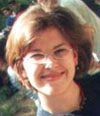The
web
site (now off-line) in Turkish of the ‘diary’ (composite of e-mails to a friend overseas) of Müsemma Sabancıoğlu is laid
out in an informal style (kept between May 2000 to Oct 2002).
Thus the translation here differs markedly in style and volume, however
I have tried to remain faithful to the original content.
Right now the in thing is Istanbul maps. As a result of fortunate circumstances, I obtained 240 sheets of Istanbul maps, done by an engineer named Pervititch, dating from 1922-45. I have examined them minutely and the detail is incredible. From the symbols on the map, one can tell on which building in which street, had a wooden structure above the brickwork or stained glass on one of the second floor windows, or a 5 stepped stairwell by the entrance etc. The man was obsessed with detail.
I have been studying the maps and Pervititch for the past 6 months (May 2000), but found nobody knew who he was, what he did or where he lived. The work was done for today’s insurance union, named at the time [Türkiye Sigortacılar Daire-i Merkeziyesi].
First went through all the phone books between 1900 and 1954 and found one Pervititch, but with the name of Auguste and thought he could be his brother. Went to the address given until 1954, as a last chance to find a trail to the man.
Arriving at the address I found a large art-nouveau building, owned for all of its 102 years by the same Jewish family. The owner lives at number 2, a talkative 87 year old Jewess. First she was puzzled by what I was saying, but later recalled and said ‘in those days my interest wasn’t the building at all but dancing, but I do recall a Monsieur Pervititch, an Orthodox Christian with 2 daughters, who was widowed young.’
However the details given didn’t match with the man. Then she added, ‘this man of yours also had a brother, and for years he lived with them, I think his name was Jacques.’ So it was his brother, I’d found my man. Mrs Sarah couldn’t remember much else, after 60 years…I wrote an article for the foundation [The Economic and Social History Foundation of Turkey], which is going to publish the entire collection of maps in one book. That’s how I got involved with the project in the first place.
I tried to get some information on Pertivititch on the Internet, but that was not possible. However a subsequent search on the Internet with a ‘t’ missing by mistake from the surname took me to the Istanbul French St Joseph Lycée web site, showing a Jacques Pervititch who graduated from the school in 1895. However phoning the school, they insisted their archives went back only to 1939, but they couldn’t explain how this information had gone on to the web. They said they would look into it. I then remembered I had a friend who had graduated from this school, and called Edhem Elhem, one of the directors of our magazine.
When I spoke to him, he told me the school archives were in the hands of a former graduate’s house, a ‘normal’ situation in Turkey. I also got in touch with the president of the alumni foundation. He got interested too, and said he would also look into it.
In the morning Mr Elhem rang:
‘This Pervititch is definitely your Pervititch’ he said. I asked him how was he so sure. Together with the head of the alumni foundation he had gone to the house of the archive keeper, who also had 2 original Pervititch maps. The archives revealed that he had come to Saint Joseph from an elementary school in Galata. He had a scholarship, was a gifted student, came first in his class, and in later years as gratitude for his bursary, donated the maps to the school with a ‘thank you’ note scribbled on the back. Edhem added, ‘since he was an exemplary student, there is a whole file on him, I haven't been able to read it all, you can pick up a photocopy of it’.
Right now the in thing is Istanbul maps. As a result of fortunate circumstances, I obtained 240 sheets of Istanbul maps, done by an engineer named Pervititch, dating from 1922-45. I have examined them minutely and the detail is incredible. From the symbols on the map, one can tell on which building in which street, had a wooden structure above the brickwork or stained glass on one of the second floor windows, or a 5 stepped stairwell by the entrance etc. The man was obsessed with detail.
I have been studying the maps and Pervititch for the past 6 months (May 2000), but found nobody knew who he was, what he did or where he lived. The work was done for today’s insurance union, named at the time [Türkiye Sigortacılar Daire-i Merkeziyesi].
First went through all the phone books between 1900 and 1954 and found one Pervititch, but with the name of Auguste and thought he could be his brother. Went to the address given until 1954, as a last chance to find a trail to the man.
Arriving at the address I found a large art-nouveau building, owned for all of its 102 years by the same Jewish family. The owner lives at number 2, a talkative 87 year old Jewess. First she was puzzled by what I was saying, but later recalled and said ‘in those days my interest wasn’t the building at all but dancing, but I do recall a Monsieur Pervititch, an Orthodox Christian with 2 daughters, who was widowed young.’
However the details given didn’t match with the man. Then she added, ‘this man of yours also had a brother, and for years he lived with them, I think his name was Jacques.’ So it was his brother, I’d found my man. Mrs Sarah couldn’t remember much else, after 60 years…I wrote an article for the foundation [The Economic and Social History Foundation of Turkey], which is going to publish the entire collection of maps in one book. That’s how I got involved with the project in the first place.
I tried to get some information on Pertivititch on the Internet, but that was not possible. However a subsequent search on the Internet with a ‘t’ missing by mistake from the surname took me to the Istanbul French St Joseph Lycée web site, showing a Jacques Pervititch who graduated from the school in 1895. However phoning the school, they insisted their archives went back only to 1939, but they couldn’t explain how this information had gone on to the web. They said they would look into it. I then remembered I had a friend who had graduated from this school, and called Edhem Elhem, one of the directors of our magazine.
When I spoke to him, he told me the school archives were in the hands of a former graduate’s house, a ‘normal’ situation in Turkey. I also got in touch with the president of the alumni foundation. He got interested too, and said he would also look into it.
In the morning Mr Elhem rang:
‘This Pervititch is definitely your Pervititch’ he said. I asked him how was he so sure. Together with the head of the alumni foundation he had gone to the house of the archive keeper, who also had 2 original Pervititch maps. The archives revealed that he had come to Saint Joseph from an elementary school in Galata. He had a scholarship, was a gifted student, came first in his class, and in later years as gratitude for his bursary, donated the maps to the school with a ‘thank you’ note scribbled on the back. Edhem added, ‘since he was an exemplary student, there is a whole file on him, I haven't been able to read it all, you can pick up a photocopy of it’.
The
dossier revealed his reports, address, that he had finished the St Pierre
junior school in Galata, and the name of his son, Henry who also went
to St Joseph.
Meanwhile, the editor of our magazine, Osman, got together a listing of expatriate Croatians resident in America, and from this I sent a blind e-mail to a Pertivititch, ‘sorry, was your grand-father’s name Jacques…’.
I went to the offices of an elderly and famous architect in the city. When prompted by the name Pervititch, he said, ‘at the academy our professors would mention his name; he had a limp in one foot, was randy and would make a plan of an area in no time’.
There is an occasional contributor to the magazine (toplumsal tarih) [social history], Rinaldo Marmara, a researcher based in France who has been studying the Latin Catholic cemetery in Feriköy for some time. He had told a friend of mine that the Pervititch grave was at Feriköy.
I went to the Catholic cemetery with a friend in the crack of the morning; Mr Marmara suggested we visit it together as he had seen it for the first time 2 or 3 years ago. The cemetery is larger than first impressions, set out in 4 blocks. Looking at the interesting tombs haphazardly noticed the one belonging to the Zellich family, a famous family who were printers in the time of Abdulhamit II, with their photos still visible. Most tombs are of marble, some very old, some mausoleums with their doors open, with icons and formerly white cloths still displayed.
Meanwhile, the editor of our magazine, Osman, got together a listing of expatriate Croatians resident in America, and from this I sent a blind e-mail to a Pertivititch, ‘sorry, was your grand-father’s name Jacques…’.
I went to the offices of an elderly and famous architect in the city. When prompted by the name Pervititch, he said, ‘at the academy our professors would mention his name; he had a limp in one foot, was randy and would make a plan of an area in no time’.
There is an occasional contributor to the magazine (toplumsal tarih) [social history], Rinaldo Marmara, a researcher based in France who has been studying the Latin Catholic cemetery in Feriköy for some time. He had told a friend of mine that the Pervititch grave was at Feriköy.
I went to the Catholic cemetery with a friend in the crack of the morning; Mr Marmara suggested we visit it together as he had seen it for the first time 2 or 3 years ago. The cemetery is larger than first impressions, set out in 4 blocks. Looking at the interesting tombs haphazardly noticed the one belonging to the Zellich family, a famous family who were printers in the time of Abdulhamit II, with their photos still visible. Most tombs are of marble, some very old, some mausoleums with their doors open, with icons and formerly white cloths still displayed.
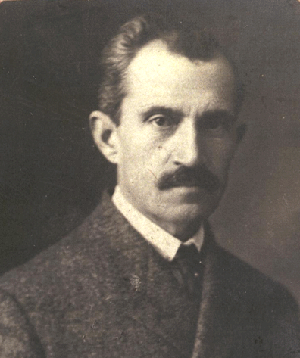 |
An early morning meeting with Rinaldo Marmara was arranged in front of that church in Beyoglu, not too far away from the more famous Santa Maria church. The priest Cecerelli met us at the door, resident there alone for 30 years. He opened up a huge cupboard for us, crammed with registers of baptisms, deaths and marriages. Having asked how far back they went, I was told they extended to the beginning of the 17th century and I was impressed by how ordered they were. We checked the death register for 1945 and found Pertivititch’s records there written in Latin. Jacques Pervititich was recorded as ‘ex Dalmatia, Iraguza born’ and had died ‘suddenly’ on the night of the 13th of December 1945. The priest recording this and overseeing the burial was a Nicolas Kiefer. We were able to discern the records of all family members this way.
Then an amazing thing happened. The priest who assisted me in going through the archives of the St Joseph Lycée found a photo of Pertivititch and sent it to me.
In between hours of Internet scanning of the name, I tried my luck by sending a blind ICQ message to a number of people of Croatia, ‘do you know a Pervititch’ and after a few negative answers, got a reply ‘yes’ from a Nenad Vekaric, somebody who had taken part in a research project. This group had done genealogical research of the families of Dubrovnic and the list included the Pervitic family. Exchanging information with my new Croatian friends, I learned that the Pervititch name was written in a different way over there, with the a and e letters joined making Internet searches redundant.
My new Croatian friend Darko Jellinich searched the name through the country’s directory enquiries that there were 2 people with the surname still living in Dubrovnik and gave me their phone numbers. Late in the evening an Artun Pervitic was called and he said that the Pervititchs were a big family in Croatia and if I would give more information, he would investigate for me, and he invited me to Croatia!
The following evening, my mobile phone rang, and it was the ambassador of the Vatican. Per Marovitch offered his help with my search for Jacques Pervititch, and I thanked him profusely.
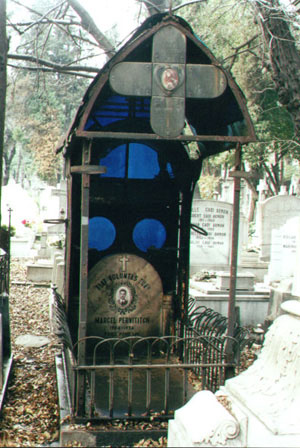 |
From the cemetery guard, I learn that
there is a gentleman by the name of Istanboluie, who visits the grave,
has it washed, leaves flowers, so obviously knows the family, but hadn't
come visiting for a year. This man is from Lebanon, and when I was at
the Lebanon consulate I was treated as a mad woman! Through the Internet
I found a Mazen Istanboluie, who had written for a certain journal.
I wrote to the editor of the journal, Robert Taggart who promptly sent
me his e-mail and house address and a note to say, hopefully he would
be helpful, and let me know of the developments.
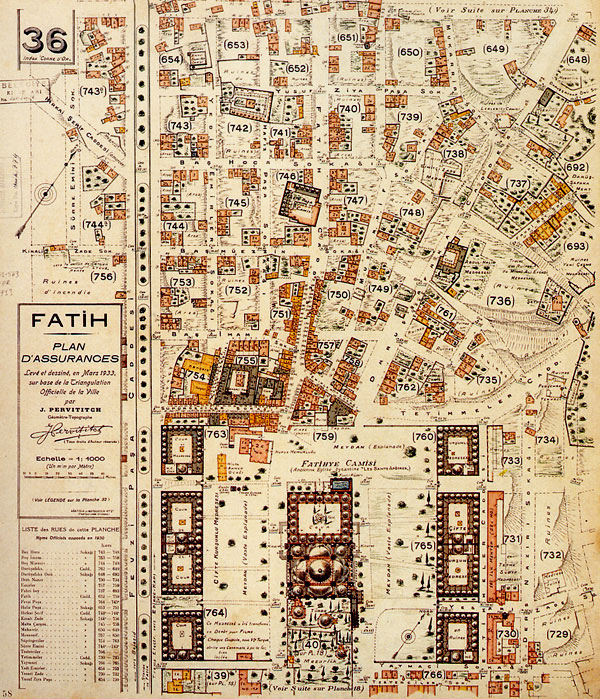 |
A reply came from Nenad Vekaric, who knew the whole branch of the family Croatia, offering to share information with what I knew of this branch. He gave the exact birth date of Jacques, 17th of February 1877 and it was his father who had emigrated to Istanbul.
The phone rang (11th of March 2002) and a lady said, ‘a month ago you enquired about a person who I think is the nephew of my mother. We knew we had relations in Istanbul but were never able to reach them. Could you tell me what you know about them’. I got another invitation from Dubrovnik with an address and I said I plan to come April or May.
The book including all the maps of Pervititch was published in January 2000, a giant red book with 334 pages. This is the book I take with me as I fly to Zagreb in June and from there to Dubrovnik. Nenad picks me at the airport and amongst other things we go to see the Ottoman archives.
Later I am in Dubrovnik and go to the institute where Nenad and Vesna (the Ottoman historian there) ask me a whole lot of questions. In the afternoon, Nenad took me to Mocici Cavtat who lived in an upmarket resort 17 km from Dubrovnic, idyllic coastline peppered with small offshore islands, mostly out of bounds as many had monasteries on them. Went to the now abandoned and dilapidated Pervitich house, single storied, made with cut stone and set in a large plot. In Croatia people's surnames are determined according to the house they live in. So Jacques Pervititch's great-great-great grandfather had the surname Voihnic, and when he moved here he took the surname of the house, Pervititch. How interesting.
We met up with Artun Pervititch who
had already got in touch with Nenad before I came here. Artun had looked
at the registers at the single church at Cavtat, after I had called
him and had found Jacques Pervititch’s birth register. Nenad had worked
in this church 10 years before. A giant of a man, Nenad is a fisherman
like the majority of the folks in the region. I showed him Jacques Pervititch’s
photographs, saying ‘here is your relative’, but didn’t seem very impressed.
He only knew vaguely that a branch of the family went to Istanbul, but
had no more information. The Pervititch’s were an extensive family in
the region anyhow, and family bonds didn’t seem as strong as that of
the Turks.
Nenad kept looking at the book and saying ‘wow’. He was impressed with the maps, and said: ‘I wasn’t expecting this much. This man is completely unknown here, we must promote him’. I said with a laugh, ‘ok let’s promote him’. The institute Nenad worked at, HAZU (Croatian science and arts institute) is one of 22 institutes across Croatia. Nenad is its head. The institute is perpetually in financial stress as would be imagined. To print the institute publication Dubrovnik Annal and in Croatian Dubrovnik Anali, they were seeking sponsors. He showed me an edition of last year’s publication with a chuckle. All the sponsors were listed inside, and announced, ‘this one is rat poison manufacturer, he is an ice-cream man, he is a tailor…’. In this way they had printed last year’s booklet with 22 sponsors and each year they have the same funding problem. The article I will be collaborating with Nenad will also feature in the same publication in the 2003 edition.
Amazing facts did not emerge with my visit to here, but I hadn’t come with high expectations, but wanted to see the place, which pleased me greatly.
Today (4th Oct 2002) I went to a newsagent and was amazed to see my article had made the front page of our magazine, not expecting this prestige.
Nenad kept looking at the book and saying ‘wow’. He was impressed with the maps, and said: ‘I wasn’t expecting this much. This man is completely unknown here, we must promote him’. I said with a laugh, ‘ok let’s promote him’. The institute Nenad worked at, HAZU (Croatian science and arts institute) is one of 22 institutes across Croatia. Nenad is its head. The institute is perpetually in financial stress as would be imagined. To print the institute publication Dubrovnik Annal and in Croatian Dubrovnik Anali, they were seeking sponsors. He showed me an edition of last year’s publication with a chuckle. All the sponsors were listed inside, and announced, ‘this one is rat poison manufacturer, he is an ice-cream man, he is a tailor…’. In this way they had printed last year’s booklet with 22 sponsors and each year they have the same funding problem. The article I will be collaborating with Nenad will also feature in the same publication in the 2003 edition.
Amazing facts did not emerge with my visit to here, but I hadn’t come with high expectations, but wanted to see the place, which pleased me greatly.
Today (4th Oct 2002) I went to a newsagent and was amazed to see my article had made the front page of our magazine, not expecting this prestige.
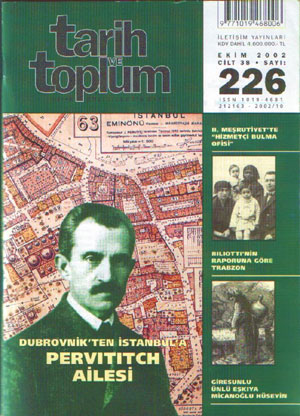 |
Notes:
1- Ms Sabancıoğlu continues to pursue other areas of research and photography as her time allows and wishes to point out a previouslly unknown historically significant (outlining territories lost by Turkey post WWI) Pervititch map, discovered in the archives of Saint Joseph Lycée by Frére Ange Michel, which she has placed on-line, and is willing to send a file to anybody who wishes to pursue this project further.
2- Amongst the publications Ms Sabancıoğlu wishes to point out are:
* A Crotian Family in Istanbul: Pervititch Family, “Dubrovnik Annal”, Dubrovnik Historical Science Institute Publication, 2003 Crotia (in English).
* Same article, “Dubrovnik Anali”, 2003 (in Croatian).
* Dubrovnik’ten İstanbul'a Pervititch Ailesi (Collobration with Nenad Vekaric Head of Dubrovnik Historical Science Institute), Tarih ve Toplum, Oct. 2002.
3- Currently (2007) Ms Sabancıoğlu is in the initial stages of creating a blog site (explanation of purpose in Turkish) to assist Turkish nationals to research their family past, a project almost unique in Turkey.

1- Ms Sabancıoğlu continues to pursue other areas of research and photography as her time allows and wishes to point out a previouslly unknown historically significant (outlining territories lost by Turkey post WWI) Pervititch map, discovered in the archives of Saint Joseph Lycée by Frére Ange Michel, which she has placed on-line, and is willing to send a file to anybody who wishes to pursue this project further.
2- Amongst the publications Ms Sabancıoğlu wishes to point out are:
* A Crotian Family in Istanbul: Pervititch Family, “Dubrovnik Annal”, Dubrovnik Historical Science Institute Publication, 2003 Crotia (in English).
* Same article, “Dubrovnik Anali”, 2003 (in Croatian).
* Dubrovnik’ten İstanbul'a Pervititch Ailesi (Collobration with Nenad Vekaric Head of Dubrovnik Historical Science Institute), Tarih ve Toplum, Oct. 2002.
3- Currently (2007) Ms Sabancıoğlu is in the initial stages of creating a blog site (explanation of purpose in Turkish) to assist Turkish nationals to research their family past, a project almost unique in Turkey.
